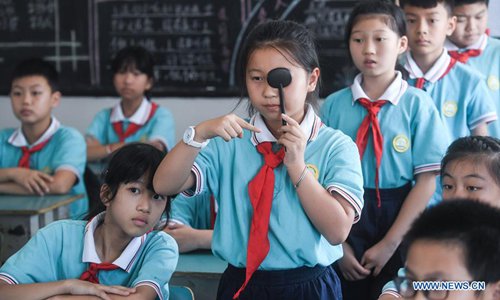Nearly 90 percent of Chinese high school students have poor eyesight: Ministry of Education
Source: Global Times Published: 2020/11/17 13:27:38

A student checks the eyesight in Donglin primary school in Donglin Township of Huzhou City, east China's Zhejiang Province, Sept. 4, 2018. Classes are being taken to popularize the knowledge of protecting eyes as China aims at curbing the rise in nearsightedness-or myopia-among children and teenagers. (Xinhua/Xu Yu)
The incidence rate of poor vision among Chinese students has risen from 59.2 percent to 70.6 percent in the past six months, according to a survey conducted in August by the Ministry of Education. Among them, the poor vision rate of high school students was 89.3 percent.
Nearly half of the 1.4 billion people around the world who are nearsighted are in China, according to the World Health Organization. Without effective intervention, it is estimated that by 2020, the number of short-sighted people in China will exceed 700 million, and the number of people with high myopia will be between 40 million and 51.5 million.
The National Health Commission (NHC) of China issued a notice Thursday, confirming that the first batch of appropriate technologies for preventing and controlling myopia among children and adolescents will be piloted in 182 districts and counties across the country, including Beijing, Tianjin, Shanghai municipalities and Hebei Province.
"What really makes children short-sighted is not the type of subject, but the system of education and electronic devices," said a netizen on Sina Weibo after the notice was introduced. The comment has received 1,171 likes by press time.
"In a few years, occupations related to precise instruments, pilots, and navigation will find the situation more challenging due to insufficient qualified candidates," another commenter said.
A city in North China's Shanxi Province set eyesight and weight as part of middle school students' graduation tests results in October as part of the city's educational reform efforts.
Local education authorities then explained that the move was aimed at encouraging teenagers to get more exercise and protect their vision.
The NHC later released a list of priorities for the prevention and control of myopia among children and adolescents, including standardizing the diagnosis and treatment of ametropia in children and adolescents, strengthening supervision and inspection of myopia among children and adolescents and ensuring eye care and visual examination for children aged 0 to six years.
Experts suggest that it is essential for people get their eyesight tested every six months to detect problems early in order to control the duration of eye use, especially sustained eye use.
Moreover, blue light from mobile phones and tablets is harmful to children. When spending too much time on phones or iPads, the eye muscles will not contract for a long time, which can cause double damage to children's eyes and lead to irreversible harm.
A mother, surnamed Guo, told the Global Times that problems such as heavy study loads and little time for extra-curricular activities have resulted in her 5-year-old child suffering myopia of 100 degrees, and the situation became more severe during the epidemic when her child had to take online classes.
Posted in: SOCIETY